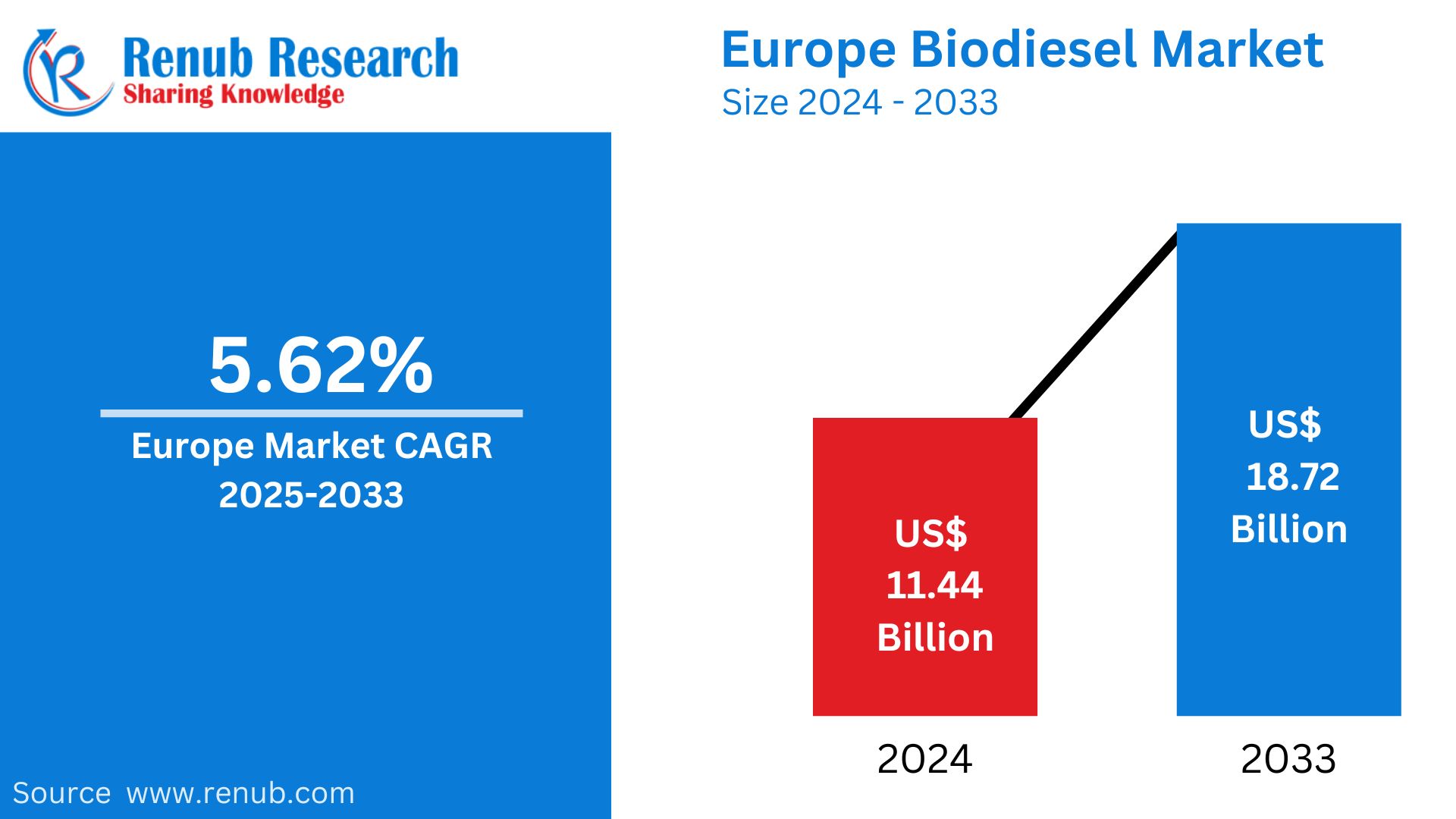
Europe Biodiesel Market Trends & Growth Outlook
Europe Biodiesel Market Set to Reach US$ 18.72 Billion by 2033, Driven by Renewable Energy Mandates and Technological Advancements
The European biodiesel market is witnessing significant growth, with an estimated size of US$ 18.72 billion by 2033, rising from US$ 11.44 billion in 2024. This represents a compound annual growth rate (CAGR) of 5.62% from 2025 to 2033. Several key factors are driving this growth, including increased adoption of renewable energy sources, supportive government policies, and a strong focus on sustainability.
A Clean and Renewable Energy Solution
Biodiesel, produced from vegetable oils, animal fats, or recycled cooking oils, is a renewable fuel offering a sustainable alternative to conventional diesel. Through the process of transesterification, oils are converted into fatty acid methyl esters (FAME), which can be blended with fossil fuels to create cleaner energy solutions for the transportation, power generation, and industrial sectors. This growing demand for cleaner fuel alternatives plays a vital role in reducing greenhouse gas emissions and enhancing Europe’s renewable energy strategy.
Growth Drivers: Renewable Energy Mandates & Technological Advancements
The European Union’s Renewable Energy Directive (RED II) is pushing the market forward by setting specific mandates for renewable fuels in the transportation sector, including a requirement for a minimum of 14% renewable energy in transport fuels by 2030. Additionally, technological advancements in biodiesel production are enhancing efficiency and expanding feedstock options, reducing production costs and enabling widespread adoption.
The emphasis on sustainability is also fueling demand, as biodiesel helps achieve carbon emission reduction targets while supporting circular economies. The European biodiesel market is rapidly becoming a key player in the energy transition, with increased government support and a growing public demand for green energy alternatives.
Challenges Facing the Market
Despite the positive growth prospects, the European biodiesel market faces significant challenges. Supply chain limitations, particularly concerning the availability of vegetable oils and animal fats, are creating instability in the raw materials required for biodiesel production. Moreover, biodiesel production costs are often higher than traditional diesel fuels, creating a competitive landscape where alternative renewable energy sources, such as hydrogen-based fuels, could pose a threat to biodiesel’s market share.
New Publish Reports
· Europe Electric Vehicle Market Size and Share Analysis – Growth Trends and Forecast Report 2025-2033
Outlook for the Future
The European biodiesel market continues to show promise as a cleaner energy source, particularly in countries like Germany, the UK, and France, where strong governmental support and a commitment to renewable energy are pushing the sector forward. Market expansion is expected to continue, with significant investments in technology and infrastructure.
Key Companies in the Market:
- Archer Daniels Midland Company
- Future Fuel
- Neste
- Renewable Energy Group, Inc.
- Bunge Global SA
- Wilmar
- Shell
For more information or to receive a custom market analysis, please contact our analysts.
Frequently Asked Questions (FAQs) – Europe Biodiesel Market
1. What is the estimated size of the Europe biodiesel market by 2033?
The Europe biodiesel market is expected to reach US$ 18.72 billion by 2033, growing from US$ 11.44 billion in 2024.
2. What factors are driving the growth of the biodiesel market in Europe?
Key growth drivers include renewable energy mandates, technological advancements in production efficiency, government policies promoting sustainability, and the shift towards greener fuel alternatives to reduce carbon emissions.
3. How does the European Union’s Renewable Energy Directive (RED II) affect the market?
RED II mandates that at least 14% of energy used in transportation must come from renewable sources by 2030, making biodiesel a key player in achieving these targets.
4. What are the challenges faced by the European biodiesel market?
Challenges include supply chain issues related to feedstock availability, higher production costs, and rising competition from other renewable energy alternatives, such as hydrogen-based fuels.
5. Which countries in Europe are leading in biodiesel production and consumption?
Countries such as Germany, United Kingdom, France, Italy, and Spain are major players in the European biodiesel market, driven by strong policies and increased public demand for cleaner energy sources.
6. What are the key applications of biodiesel in Europe?
Biodiesel is widely used in transportation, power generation, and industrial applications, including heating systems and machinery.
7. What feedstocks are primarily used for biodiesel production in Europe?
The primary feedstocks include vegetable oils (such as rapeseed oil) and animal fats.
8. How is technological advancement influencing biodiesel production?
Technological advancements have led to increased production efficiency, lowered costs, and the ability to use a broader range of feedstocks, enabling the growth of the biodiesel market in Europe.
9. Who are the major companies operating in the European biodiesel market?
Key players include Archer Daniels Midland Company, Future Fuel, Neste, Renewable Energy Group, Inc., Bunge Global SA, Wilmar, and Shell.
10. What is the expected growth rate for the European biodiesel market?
The market is expected to grow at a CAGR of 5.62% from 2025 to 2033.